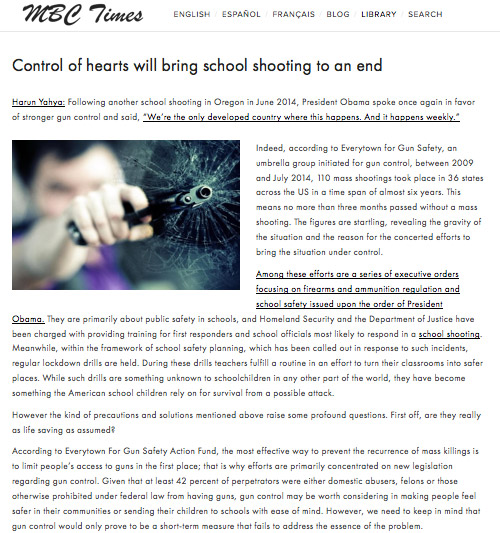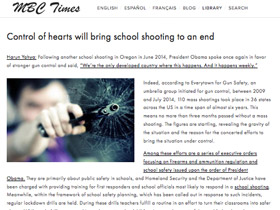
Following another school shooting in Oregon in June 2014, President Obama spoke once again in favor of stronger gun control and said, “We’re the only developed country where this happens. And it happens weekly.” [1]
Indeed, according to Everytown for Gun Safety, an umbrella group initiated for gun control, between 2009 and July 2014, 110 mass shootings took place in 36 states across the US in a time span of almost six years. This means no more than three months passed without a mass shooting. The figures are startling, revealing the gravity of the situation and the reason for the concerted efforts to bring the situation under control.
Among these efforts are a series of executive orders focusing on firearms and ammunition regulation and school safety issued upon the order of President Obama.[2] They are primarily about public safety in schools, and Homeland Security and the Department of Justice have been charged with providing training for first responders and school officials most likely to respond in a school shooting. Meanwhile, within the framework of school safety planning, which has been called out in response to such incidents, regular lockdown drills are held. During these drills teachers fulfill a routine in an effort to turn their classrooms into safer places. While such drills are something unknown to schoolchildren in any other part of the world, they have become something the American school children rely on for survival from a possible attack.
However the kind of precautions and solutions mentioned above raise some profound questions. First off, are they really as life saving as assumed?
According to Everytown For Gun Safety Action Fund, the most effective way to prevent the recurrence of mass killings is to limit people’s access to guns in the first place; that is why efforts are primarily concentrated on new legislation regarding gun control. Given that at least 42 percent of perpetrators were either domestic abusers, felons or those otherwise prohibited under federal law from having guns, gun control may be worth considering in making people feel safer in their communities or sending their children to schools with ease of mind. However, we need to keep in mind that gun control would only prove to be a short-term measure that fails to address the essence of the problem.
The perpetrators of mass shootings are all too often individuals who have been raised in environments in which their role-models either display destructive behaviors or, at least, lack wholesome conduct. In the absence of good role-models to imitate, these individuals remain vulnerable to vileness and remain inclined to commit unfavorable acts. That is why, while considering the measures to take against mass killings, it would be a mistake not to take these negative role-models being emulated by potential perpetrators into account.
It should also be kept in mind that the existence of crimes of any kind in a society reflects the level of moral uprightness of the individuals living there. The well-being of a society relies on the existence of people with moral excellence who are willing to improve the ethical standards and work for the peaceful functioning of the community. Virtuous people’s being in the majority in a society will foster a sense of self-worth, decency and goodwill in other individuals, and especially in younger generations, which will prove to undergird a mentally and morally upright society.
In the long term, passing gun legislation reform in the US is not a solution to the school killings. It is evident that there is a need to change the soul of the society for the better and this change will only be accomplished if it starts from hearts and minds. So long as feelings of hatred and rage are not eradicated and replaced with love and compassion for others, such massacres and other similar forms of crime will continue to threaten societies.
Adnan Oktar's piece on MBC Times:
http://www.mbctimes.com/english/control-of-hearts-will-bring-school-shooting-to-an-end


